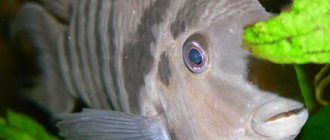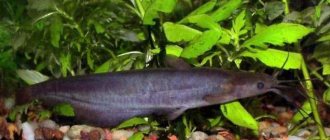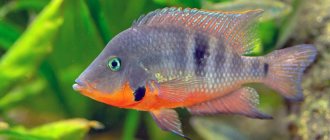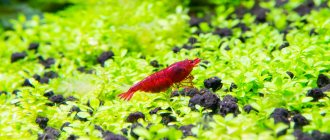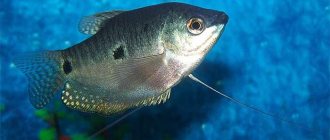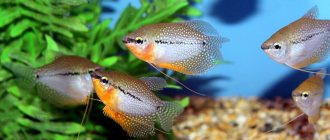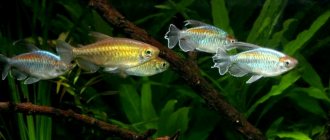WITH GUPPY
Guppy is an unpretentious fish . It has good endurance and is harmless.
Angelfish can get along with this fish only in a few cases:
- the fish is still small;
- The vegetation in the aquarium predominates; in case of danger, the guppy can easily hide in it.
Otherwise, these two fish are practically incompatible. Even a couple of angelfish can snack on a flock of peaceful guppies. This predator especially loves to feast on baby guppies.
Video: how do they live with neons?
With barbs
Some tables indicate that barbs can be added to angelfish. But in reality this turns out to be absolutely not the case. A war may begin among the fish, and it will end not in favor of the angelfish. Especially if Sumatran barbs become neighbors. Initially, these fish live quietly and are engaged in reconnaissance of the situation. As soon as they settle in the aquarium, they will begin to attack the angelfish.
You may be interested in the striped catfish, its behavior in the aquarium, its methods of care and feeding.
You can learn how angelfish reproduce at home from here.
It describes the parrot fish, maintenance, feeding, and spawning process.
Description
Angelfish (Pterophyllum) belongs to the cichlid family. It has a rounded body whose height exceeds its length.
The fins of these fish are no less interesting. Abdominal - thread-like, excessively elongated. The dorsal and anal are increased in size and have an elongated shape. The pectoral fins and tail have pointed tips.
Elongated fins (dorsal and anal) illusoryly give the angelfish the outline of a crescent. Its body measures up to 25 cm in height and up to 15 cm in length.
It is difficult to identify the main colors of angelfish. They are very diverse: from gray-greenish to deep olive with a rainbow or silver tint.
Sexual characteristics in this species are not clearly expressed. In this case, the male can be distinguished by a more convex frontal part.
How long do angelfish live in a home aquarium? Under normal conditions, the lifespan of these fish can exceed 10 years.
COMPATIBILITY WITH COCKERS
These fish get along well with each other, but each of them simply prefers not to notice its own neighbor. Moreover, cockerels fight among themselves everywhere.
But do not forget about the change in character of angelfish during spawning. They become overly aggressive, and if the cockerels give even the slightest reason, the angelfish will quickly attack them.
To prevent this from happening, you need to plant as many plants as possible in the aquarium in which the fish could hide.
Maintenance and care
We should not forget that the care and maintenance of angelfish aquarium fish are closely related to their natural preferences. In an aquarium, the volume of which should not be less than 100 liters per couple, large-leaved algae must be planted. This will require a sufficient water level (at least 50 cm).
Alone, the scalar feels uncomfortable. This will sooner or later lead your pet to stress, illness, and a shortened life span. At a minimum, this fish should have a pair, or better yet, a whole family of 6 or more individuals.
Another feature of the species is the dominant hierarchy of one pair. Leaders demonstrate their superiority over other group members in different ways. “Intra-family” conflicts are possible, but, as a rule, there are no serious casualties.
The soil for angelfish can be coarse sand or small pebbles, suitable for planting.
The reservoir should be divided into zones. Fish should be able to hide in dense thickets in case of aggression from “neighbors” and swim freely in open areas when everything is quiet.
A positive feature of angelfish is their calm attitude towards decorative objects and plants. They are indifferent to the underwater surroundings: they do not dig the soil and do not spoil the “design of the room” in any way.
Water quality is of great importance for these fish. It must be clean and well saturated with oxygen. To do this, it is advisable to use filters with external mounting and sufficiently powerful aerators.
The lighting of the pond can be bright or slightly dim. For this type of underwater inhabitants it is not of great importance. In this case, you will have to select the appropriate type of plants.
Water for angelfish in an aquarium should have the following parameters:
- temperature - +24C -+28C;
- hardness – 1 – 15 units;
- acidity – 6 – 7.4 units.
A weekly water change of 25–30% of the total volume will be required.
WITH DISCUSSIONS
These fish have a lot in common. For example:
- love to eat to the point of gluttony;
- similar in content;
- They live exclusively in flocks.
The aquarium should be large so that both species have their own place. In this case, the fish will not begin to quarrel.
Video: different fish in the aquarium
Zebrafish Compatibility
If you look at the pedigree of the zebrafish, you can find out that the common carp is a distant relative of this fish. Danio has an absolutely flexible character . The fish swim peacefully and do not bully their neighbors.
However, it is worth remembering that this fish does not tolerate loneliness, so you need to start a small flock right away . Angelfish, in turn, show no interest in calm zebrafish.
Selection of fish
We have already talked about the fact that it is undesirable to keep angelfish with goldfish. Let us explain: cichlids are thermophilic, but these, on the contrary, love cool water. In addition, goldfish are big gluttons, heavily litter the aquarium and love to dig, and angelfish cannot tolerate dirty water.
Herbivorous fish (tilaria, hemigrammus, viviparous carp-toothed fish) and predators, which include angelfish, should not be kept together. Mixing different feeds can have a negative impact on the condition of the water and the health of its inhabitants.
COMPATIBILITY WITH PECILIAS
Angelfish show complete indifference at the sight of platies . It would seem that the angelfish does not like fry. However, she doesn’t even think about bullying kids and platies. There is no mutual hostility observed .
Ornamental platies: keeping and caring for them, features of the reproduction process, diet.
Description of the neon iris, methods of maintenance and care in the aquarium, its arrangement, -
Types of angelfish
Continuous crossing of angelfish has yielded results. Today it is difficult to say with certainty what kind of fish we have in front of us, although there are only three of their classical forms.
Common (Pterophyllum scalare). In nature, it has a silver body color with four transverse stripes.
Leopold (Pterophyllum leopoldi). Representative of small angelfish. A distinctive feature of the species is a large dark spot in the area of the dorsal fin.
Altum (Pterophyllum altum) or Orinoco. The largest fish, the size of which can reach 40 cm. In addition to its large size, it has other distinctive features. This is a sharp, indented transition from the forehead to the mouth and red dots on the fins.
Long-term crossing of the main species of angelfish has led to the appearance of a large number of colors:
- marble;
- leopard print;
- lace;
- tricolor (koi);
- two-color (biocolor);
- pearl (diamond);
- Red Devil;
- black;
- train (veil).
Who will make a good neighbor?
When choosing these representatives, you don’t have to worry that this cohabitation will bring harm or death to one of the aquarium fish. The listed species coexist in the aqua world compatible with angelfish.
- Corydoras catfish. Thanks to their slowness and calm disposition, catfish are able to coexist in a common aquarium with almost all representatives of fish. Since catfish spend most of their lives at the bottom, “angels” simply will not notice them, so they would live in peace and tranquility.
- Cockerels. They get along well with small individuals. They are more likely to conflict with each other than with other species. But during spawning, the angelfish becomes more aggressive, so during this period it is recommended to relocate the cockerels or provide them with places to hide.
- Danio. They will become good roommates if they grew up together, like swordtails and angelfish. If you add them to already adult individuals, the latter will perceive the former as food and will begin to hunt them. The surviving fish will also not be able to exist in peace; the angelfish will not miss the opportunity to attack them, especially at night.
- Platies and mollies. Angelfish get along well with them, since the latter simply do not notice their appearance, which means they do not show aggression.
- Rainbows. They get along well if they grow together. But even in this case, angelfish tend to hunt iris, which are small in size, awakening the predatory instinct in them.
- Angelfish and neons. Although neons live on the bottom and rarely encounter each other, they sometimes display their hunting instincts. Neonies are especially attacked by newcomers who are placed with already adult individuals.
In addition, they are good neighbors for angelfish and gouramis. They are large fish and look harmonious in one aqua world. But even here you need to remember about the joint maturation of aquarium fish. Otherwise, there is a risk that they will strongly conflict and hunt each other. Many aquarium owners recommend such neighbors as tetras and labeos. If they grew up together, then their coexistence will be calm and comfortable.
Aquarium fish - pseudotropheus - get along well, however, situations often occur when pseudotropheus show excessive aggression and gnaw on the fins of their neighbors. This especially happens with unsystematic feeding. Therefore, when adding, you need to monitor the behavior of the fish.
Bad company
Among the bad neighbors, barbs and cockerels are noted. Angelfish do not live together for long and with harm to them and themselves. Practice confirms this in many cases. Barbs bite the fins of angelfish, and they respond by attacking the offenders if they are careless. The problem can be solved by adding small-sized barbs to adult angelfish. Then the little thing will always be afraid of touching its large neighbors, but there remains the risk of scalars attacking baby barbs.
Angelfish and barbs are conditionally compatible. Those. their compatibility depends on many factors and is difficult to arrange.
Roosters are bad neighbors. This fish has a quarrelsome nature due to its extreme territoriality. Female bettas are less aggressive, but because of this, catfish can become victims of angelfish. Cockerels and angelfish are bad company and should not be placed in the same aquarium.
African and South American large cichlids are not suitable for keeping with angels.
Catfishes with suckers require careful introduction into a body of water: Ancistrus, Herinocheilus. If there is a lack of feeding, they will show predatory traits. Namely, they will attach themselves to the wide sides of the angelfish and eat their scales. Other unsuitable neighbors are listed in the following list:
- Guppies and thorns provoke larger fish to hunt, as do other small things.
- And again the barb: active, but unfriendly, chasing the angelfish, bringing it to stress. He grabs her by the fins and may not let her near the feeder. The fire barb, for example, is the most beautiful representative, but quite a bully.
- Goldfish are completely incompatible - fish prefer different habitats. Veiltails love cool weather and eat vegetation. And angelfish live in warm water and need greenery around them.
- Astronotuses are bloodthirsty predators; they live only with their own species or fish of a similar size.
- Predatory behavior has been observed in pacu and discus fish.
- Shrimp can create a controversial situation. In some cases they live quietly side by side, and in others they are food for angelfish. Everything is decided on an individual basis. But the risk is very high.
Who can you live with and who can’t you live with?
Based on all that has been said, we will draw up a table from which you can see with whom angelfish get along and with whom it is better not to mix them:
If we talk about the compatibility of different types of scalars, we can confidently say that it is possible, but subject to the conditions. Although the species lives in a school, new fish cannot be added to adult individuals. A hierarchy always forms in a group, and a newcomer will become an outcast. This is especially visible if there is only one pair of “angels” in the aquarium - they will immediately put the “third wheel” in his place. If all the fish have been familiar since childhood and the conditions in the aquarium are favorable, they live calmly, even if they belong to different species.
Did you like the article and find it useful? Share it with your friends on social networks. Share your own experience of keeping pets in the comments and don’t forget to like.
Leisurely underwater predator
They certainly didn’t get the name “angel fish” for their peaceful disposition. Most likely, for its leisurely movements and attractive appearance. Angelfish are measured and unpretentious. In general, they are not too conflicting, but it is better not to keep small fish - for example, neons, veils - with them. Angelfish will maul them or eat them. Anything smaller than them is mistaken for food and swallowed. This is because they are cichlids and predators.
Characteristics of the angelfish:
- fish need to live in a school, they cannot exist safely alone;
- permanent pairs are created for spawning;
- there is subordination among pairs, the best place in the aquarium is occupied by the largest pair, and individuals without a pair become outcasts;
- fish are very timid: if you suddenly knock on the glass of the aquarium or suddenly turn on the light, you will notice how frightened the angelfish are, they can even change colors out of fear.
Keep in mind that when buying a pair, you risk getting 2 females, and one of them will imitate the behavior of the male. Even the eggs are “fertilized.” Naturally, nothing will work out for her. If you want to get your own offspring, then purchase several fish at once.
We recommend reading
Varieties of algae eaters in the aquarium
What to look for when choosing “neighbors”?
Despite the fact that this species is considered peaceful and calm, you need to remember that they belong to the cichlid family, which means they have a predatory instinct. It follows from this that not every aquarium fish is suitable for angelfish in terms of compatibility with other fish. For example, small fish should not be added to them, as they will easily eat them. On the other hand, large breeds of fish that show aggression towards others will begin to attack themselves. The main rule that needs to be remembered when angelfish are compatible with other fish: they are able to get along with many and coexist peacefully if they grow and mature together from birth. Then, even as adults, they will easily recognize their neighbors and distinguish them from newcomers.
Look at a community aquarium with angelfish.
Conditions for peaceful detention
The main condition for peaceful maintenance is a large space. In a compact aquarium, even peaceful inhabitants conflict. Each species must have a place to move. If there is not enough space, the best solution is to place the species in separate aquariums.
Another condition is a comfortable life for each pet. Do not introduce nimble, voracious individuals. They eat all the food, leaving others hungry.
For peaceful coexistence of pets, purchase them at a young age. Inhabitants who have grown up together are not prone to conflict, unlike adult individuals who have been housed together.
